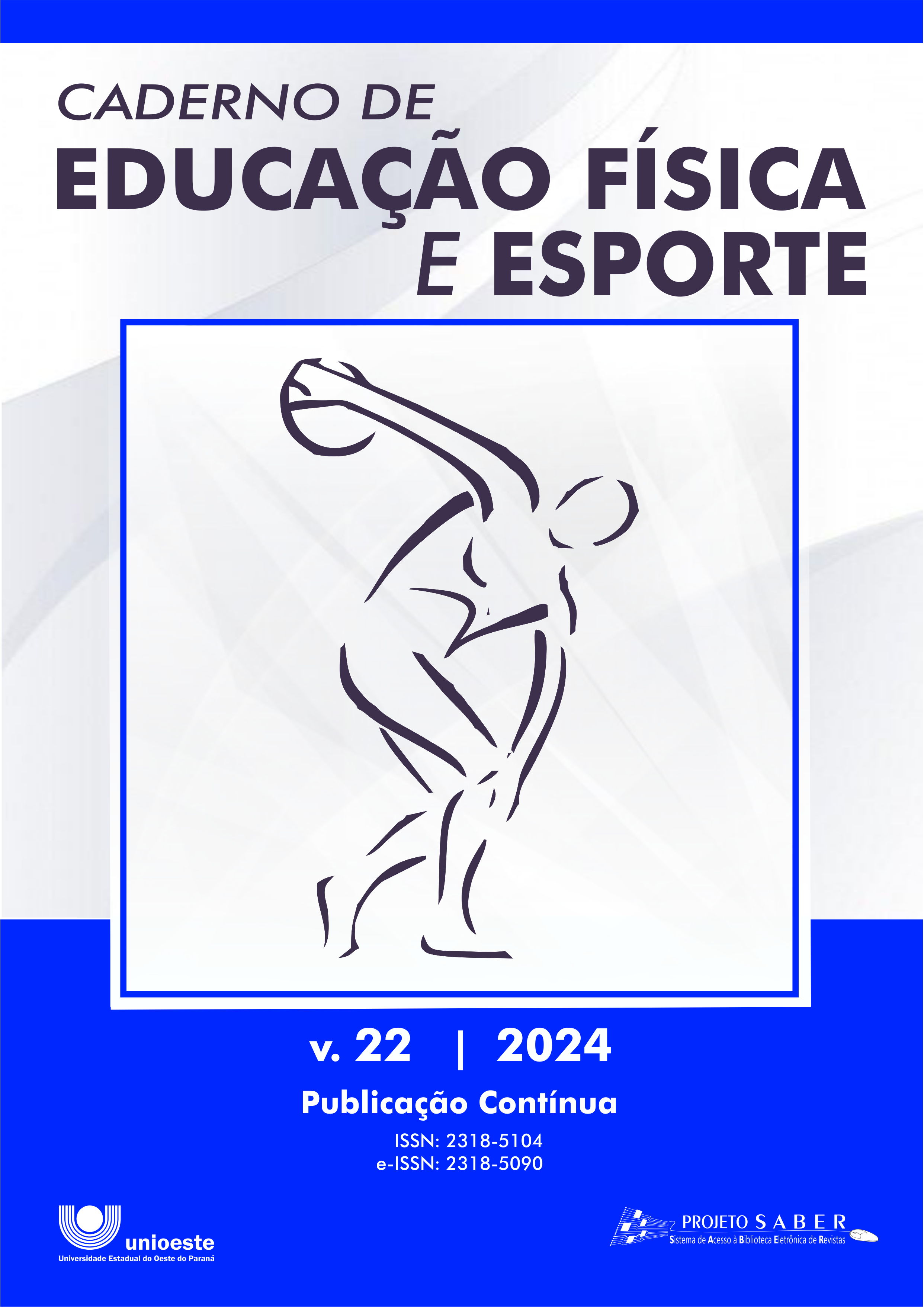Methods of sports training for athletes with cerebral palsy: a systematic review
DOI:
https://doi.org/10.36453/cefe.2024.32746.0Keywords:
Cerebral palsy, Para-athletes, Training, Sports, PerformanceAbstract
BACKGROUND: Despite adversities, the participation of athletes with disabilities in sports competitions has grown substantially over the years, making a notable presence in the Paralympic Games. The characteristics stemming from cerebellar paralysis in parathletes profoundly impact the lives and sporting practices of these individuals, ranging from muscular weakness to multifactorial motor impairment, including spasticity, dystonia, muscular contractures, and bone deformities.
OBJECTIVE: To identify training methods for athletes with cerebral palsy.
METHODS: A systematic review was conducted to identify in the PubMed and Web of Science literature databases that intervened through training methods in athletes with cerebral palsy in sports disciplines, comparing results before and after the intervention. Combinations of the following search terms were used: “cerebral palsy” combined with “Paralympic”, “para-athlete” and “athlete”, as well as with “sport performance”, “training”, “preparation”, “coaching”, “teaching”, “method” and “performance”. The article selection process followed the PRISMA protocol and resulted in five articles.
RESULTS: Five articles were found after conducting the systematic review. The main results indicated the use of non-sport-specific components in part of the training program; the use of methods involving high speed and self-training with soccer and powerlifting athletes; and tools like blood flow restriction in track and field athletes. Tools that develop physical fitness for sports were the most discussed interventions, especially strength training
CONCLUSION: These findings contribute to assisting in the formulation of a training program for individuals with cerebral palsy aimed at sports performance.
Downloads
References
BECKMAN, E. M.; CONNICK, M. J.; TWEEDY, S. M. Assessing muscle strength for the purpose of classification in Paralympic sport: A review and recommendations. Journal of Science and Medicine in Sport, v. 20, p. 391-6, 2016. DOI: http://doi.org/10.1016/j.jsams.2016.08.010
FLEETON, J. R. M.; SANDERS, R. H.; FORNUSEK, C. Strength training to improve performance in athletes with cerebral palsy: A systematic review of current evidence. Journal of Strength and Conditioning Research, v. 34, n. 6, p. 1774-89, 2020. DOI: http://doi.org/10.1519/JSC.0000000000003232
GAWRONSKI, W. From injury to the paralympic podium – A case study of a cross-country skiing champion in 10-year follow-up. British Journal of Sports Medicine, v. 48, p. 599, 2014. DOI: https://doi.org/10.1136/bjsports-2014-093494.107
GEORGIEVICH, M.; AL-SOUB, M. A. W. K. Analysis of the training of 17-18-year-old male powerlifters with cerebral palsy. Revista EuroAmericana de Ciencias del Deporte, v. 11, Supplement 2, Article 15, 2022. DOI: http://doi.org/10.6018/sportk.517121
GIMÉNEZ FUENTES-GUERRA, F. J. Fundamentos básicos de la iniciación deportiva en la escuela. Seville: Wanceulen; 2000.
GORMLEY JR., M. E. Treatment of neuromuscular and musculoskeletal problems in cerebral palsy. Pediatric Rehabilitation, v. 4, n. 1, p. 5-16. 2001. DOI: http://doi.org/10.1080/13638490151068393
HOLLAND, L. J.; STEADWARD, R. D. The effects of weight training and flexibility exercising on the strength, range of motion, and spasticity/muscle tone of elite cerebral palsy athletes. In: DOLL-TEPPER, G.; DAHMS, C.; DOLL, B.; VON SELZAM, H. (Eds.). Adapted physical activity. Berlin: Springer, 1990. p. 125-9.
KLENCK, C.; GEBKE, K. Practical management: Common medical problems in disabled athletes. Clinical Journal of Sport Medicine, v. 17, p. 55-60, 2007. DOI: http://doi.org/10.1097/JSM.0b013e3180302587
MOREAU, N. G.; HOLTHAUS, K.; MARLOW, N. Differential adaptations of muscle architecture to high-velocity versus traditional strength training in cerebral palsy. Neurorehabilitation and Neural Repair, v. 27, p. 325-34, 2012. DOI: http://doi.org/10.1177/1545968312469834
PARALYMPIC GAMES. De 6 de novembro de 2006. Disponível em: http://www.paralympics.org. Acessado em: 25 de setembro de 2023.
PEÑA-GONZÁLEZ, I.; MOYA-RAMON, M. Physical performance preparation for the cerebral palsy football world cup: A team study. Apunts Sports Medicine, v. 58, n. 218, Article 100413, 2023. DOI: http://doi.org/10.1016/j.apunsm.2023.100413
PEÑA-GONZÁLEZ, I.; SARABIA, J. M.; MANRESA-ROCAMORA, A.; MOYA-RAMON, M. International football players with cerebral palsy maintained their physical fitness after a self-training program during the COVID-19 lockdown. PeerJ, v. 10, e13059, 2022. DOI: http://doi.org/10.7717/peerj.13059
RODRÍGUEZ MACÍAS, M.; GIMÉNEZ FUENTES-GUERRA, F. J.; ABAD ROBLES, M. T. The sport training process of para-athletes: A systematic review. International Journal of Environmental Research and Public Health, v. 19, n. 12, Article 7242, 2022. DOI: http://doi.org/10.3390/ijerph19127242
ROTTA, N. T. Paralisia cerebral, novas perspectivas terapêuticas. Jornal de Pediatria, v. 78, Suplemento 1, p. 48-54, 2002. DOI: https://doi.org/10.1590/S0021-75572002000700008
SALVADOR, A. F.; SCHUBERT, K. R.; CRUZ, R. S. O.; CORVINO, R. B.; PEREIRA, K. L.; CAPUTO, F.; OLIVEIRA, M. F. M. Bilateral muscle strength symmetry and performance are improved following walk training with restricted blood flow in an elite paralympic sprint runner: Case study. Physical Therapy in Sports, v. 20, p. 1-6, 2016. DOI: http://doi.org/10.1016/j.ptsp.2015.10.004
SILVA, D. B; LIMA, M. C. Características epidemiológicas da paralisia cerebral em crianças e adolescentes em uma capital do nordeste brasileiro. Fisioterapia em Movimento, v. 27, n. 4, p. 567-76, 2020. DOI: http://doi.org/10.1590/1809-2950/20012527042020
SZAFRANIEC, R.; KISILEWICZ, A.; KUMOREK, M.; KRISTIANSEN, M.; MADELEINE, P.; MROCZEK, D. Effects of high-velocity strength training on movement velocity and strength endurance in experienced powerlifters with cerebral palsy. Journal of Human Kinetics, v. 73, p. 235-43, 2020. Disponivel em: https://johk.pl/?p=5628
TAKARADA, Y.; TAKAZAWA, H.; SATO, Y.; TAKEBAYASHI, S.; TANAKA, Y.; ISHII, N. Effects of resistance exercise combined with moderate vascular occlusion on muscular function in humans. Journal of Applied Physiology, v. 88, n. 6, p. 2097-106, 2000. DOI: http://doi.org/10.1152/jappl.2000.88.6.2097
Published
How to Cite
Issue
Section
License
Copyright (c) 2024 Direitos Autorais Partilhados

This work is licensed under a Creative Commons Attribution-NonCommercial-ShareAlike 4.0 International License.
Os direitos autorais permitem descarregar, compartilhar, copiar, distribuir, adaptar, transformar, exibir, reproduzir a totalidade ou partes do artigo para qualquer propósito legal, desde que não tenha fins lucrativos e seja citada a fonte.
Informamos que todo o conteúdo do texto publicado, e dos seus possíveis erros ortográficos e gramaticais, é de inteira responsabilidade de seus autores, não cabendo ao Caderno de Educação Física e Esporte, ou aos nossos Avaliadores Ad Hoc, por qualquer implicação legal ou por eventual negligência à língua portuguesa ou à estrangeira.



















